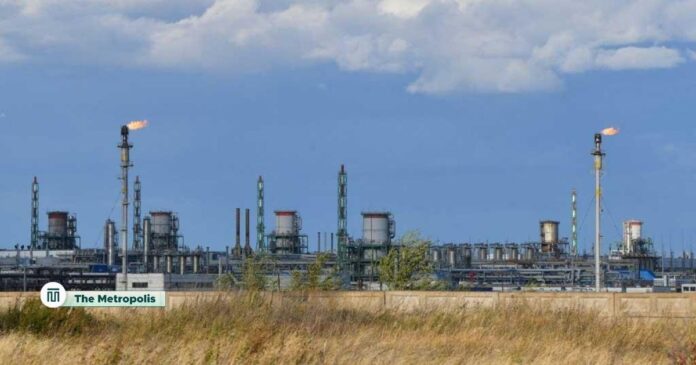Russia stopped supplying gas to Austria on Saturday due to a payment dispute, but it continued to send large amounts of gas to Europe through Ukraine after the remaining buyers requested more gas.
Russia, which was Europe’s largest natural gas supplier prior to the conflict in Ukraine, has lost nearly all of its European clients as the EU attempts to lessen its reliance on it and following the 2022 explosion of the Nord Stream pipeline to Germany.
The Soviet-era Urengoy-Pomary-Uzhgorod pipeline, which carries gas from northern Siberia to Slovakia, the Czech Republic, and Austria, is set to close at the end of this year because Kyiv does not want to extend a five-year transit agreement. This pipeline is one of the last major Russian gas routes to Europe.
Russia’s state company Gazprom GAZP.MM awarded OMV, Austria’s largest energy supplier, an arbitration award for unfulfilled supplies to its German unit, and Austria said Friday that Moscow had told it that the gas would be cut off.
Austria’s energy watchdog E-Control announced on Saturday that Gazprom’s supplies to OMV had ceased at 6 a.m. (0500 GMT), but that prices and supplies for Austrian consumers remained stable.
In essence, OMV is halting some payments for gas supplied through Ukraine by attempting to recoup the 230 million euro ($242 million) damages awarded during arbitration from Gazprom by offsetting the claim against invoices for deliveries to Austria.
Although the Russian company declined to comment on the suspension of gas flows to Austria, Gazprom announced that it would ship 42.4 million cubic meters of gas to Europe via Ukraine on Saturday. This amount is the same as it was on Friday and every other day in recent months.
Russian gas is still being supplied to SPP, a state-owned company in Slovakia, and more people are purchasing it.
The SPP statement did not identify the other purchasers. “The situation where a large consumer stopped taking gas from the east, but the same volume flows through the territory of Ukraine, shows that there is still great interest in this gas in Europe,” the statement said.
About 40% of Russian gas flows through Ukraine are typically OMV, or about 17 mcm per day.
According to AGGM, the Austrian grid operator, it is not currently replacing imports from Italy or Germany. Austria previously stated that it had enough supplies to make up the difference.
POLITICS OF GAS
On Friday, Chancellor Olaf Scholz had his first conversation with President Vladimir Putin in almost two years as European leaders await Donald Trump’s proposals to end the largest land war in Europe since World War Two.
The Kremlin claims that Putin advised Scholz that Russia was “ready for mutually beneficial cooperation if the German side shows interest in this” and that Russia had always complied with its contractual obligations regarding energy supplies.
After significant Siberian gas deposits were discovered in the years following World War II, Soviet and post-Soviet leaders invested fifty years in creating an energy industry that connected the Soviet Union, Russia, and Germany, the largest economy in Europe.
That connection has been severed by war and explosions, harming both nations’ economies.
Gazprom has lost market share to Norway, the United States, and Qatar since the war began in 2022, although at its height, Russia supplied 35% of Europe’s gas.
A dispute led to the closure of the Yamal-Europe pipeline via Belarus, and Russia accused Britain and the United States of being responsible for the explosions beneath the Baltic Sea that shut down the Nord Stream route.
London and Washington have denied that they detonated the pipelines. The attack was carried out by Ukrainian officials, according to the Wall Street Journal. Kyiv has refuted that claim.
In the absence of Austria, major Russian supplies will only reach Slovakia and Hungary, the latter through a pipeline that primarily passes through Turkey.
Data compiled by Reuters shows that in 2023, Russia shipped approximately 15 billion cubic meters of gas through Ukraine, which accounted for around 8% of the peak Russian gas flows to Europe via various routes in 2018-2019.
According to the International Energy Agency, the Ukraine transit route satisfied 65% of Austria’s and its eastern neighbours Hungary’s and Slovakia’s gas needs in 2023.
Create an account
Welcome! Register for an account
A password will be e-mailed to you.
Password recovery
Recover your password
A password will be e-mailed to you.
20.8
C
New York
Wednesday, June 11, 2025
The Metropolis is an online podium for journalism, presenting stories behind stories. The new breed of digital newspaper taps into possibilities and reflects on solutions. The boom of digital journalism has made shareable items sprout and bitesize contents mushroom. But, the depth and dimension gap is still wide open. That’s where The Metropolis, a news and content portal, makes a difference, delivering facts to inform, inspire, and include.
Contact us: themetropolisreport@gmail.com
© Copyright - The Metropolis by Reactron Global



